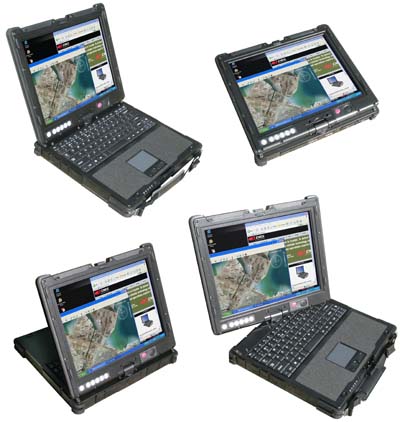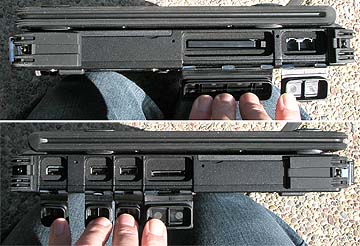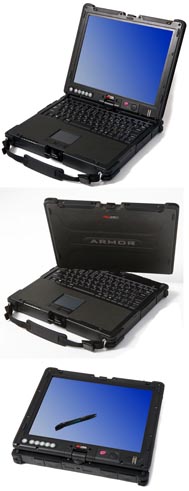|
DRS ARMOR C12
Compact, rugged Tablet PC convertible takes on established competition
(by Conrad H. Blickenstorfer)
In February of 2008, DRS Tactical, located in Melbourne, Florida, announced ARMOR, a line of rugged mobile computers with an emphasis on data protection technology, anywhere connectivity and sunlight readable display options for industrial and government customers. The initial products of the ARMOR line include the C12 notebook convertible shown here and the X10 Tablet.

Before becoming part of DRS, DRS Tactical was WalkAbout and had its origins in rugged tablet computers. The C12 is the company's first notebook or notebook convertible other than the military market that came from the DRS side of the company.
With the magnesium-bodied ARMOR C12, DRS Tactical joins the market of compact rugged notebook convertibles pioneered by Panasonic with the Toughbook CF-19 several years ago and more recently joined by the GETAC V100. As shown above, the C12 can be used as a notebook, or the screen can be rotated and then folded down flat onto the keyboard, LCD facing up.
The C12, which weighs just a bit more than five pounds, has a 12.1-inch display with a touch screen and a very strong 600 nit backlight (compared to less than 200 nits for most commercial notebooks) for outdoor readability. Even though the machine runs the Tablet PC Edition of Windows XP, an active digitizer version is not offered at this time.
Frugal performer
DRS chose the 1.2GHz U1400 Intel Core Solo processor for the C12. This is an ultra-low voltage chip that dissipates just 5.5 watts of power and allowed DRS to forego a fan. However, the Core Solo processor is not known as a speed demon and we wondered how it compared to machines with faster CPUs. To find out we installed Passmark Software's PerformanceTest 6.1 that runs about 30 tests covering CPU, 2D graphics, 3D graphics, memory, and disk and then computes scores for each category and an overall PassMark score. For comparison we used an older Toshiba Portege M205-S809 Tablet PC convertible that is similar in size and weight to the C12 and has perfectly adequate performance. Both machines ran the Tablet PC Edition of Windows XP. They scored as follows:
|
PERFORMANCE
|
DRS C12 (1.2GHz U1400)
|
M200 (1.5GHz Pentium M)
|
|
CPU Mark
|
329.4
|
322.9
|
|
2D Graphics Mark
|
174.7
|
162.8
|
|
Memory Mark
|
251.4
|
208.1
|
|
Disk Mark
|
247.9
|
138.6
|
|
3D Graphics Mark
|
87.0
|
36.7
|
|
Overall PassMark
|
218.7
|
179.6
|
Despite its very energy-efficient processor, the C12 beat the M processor machine that ran at a higher clock speed (1.5GHz versus 1.2 GHz) and consumes a good deal more power in every category. It may not keep up with a high-speed Core 2 Duo, but it is fast enough and the total absence of fan noise is certainly a plus. Amazingly, even without a fan, the DRS C12 hardly warms up at all. Low design power has its advantages.
The processor choice also benefits battery life, especially in conjunction with a generously sized 58 watt-hour power pack that provides up to eight hours of operation between charges even with the unit's strong backlight (the brochure says "4-6 hours actual usage"). The 60GB hard disk is shock-mounted and removable, and a 32GB solid state disk is optional and recommended for optimal speed and maximum mean time between failure.
Well connected
The CF-12 has good on-board connectivity. There are three USB 2.0 ports, a serial port for legacy peripherals, a modem, gigabit LAN (only 10/100, audio, and UXGA video. All ports are covered or sealed. Below you can see the backside of the C12 with power, audio, serial and video. The hinged covers are made of tough plastic outside and with a rubber seal inside. Two O-ring style friction seals hold them in place. Should a cover rip off or get damaged, it can easily be replaced. All you have to do is undo a couple of Philips screws and put the new cover in place.

Below are views of the left and right side of the C12. On the right side (top picture) you see the PC Card slot and the RJ11 modem and RJ45 LAN jacks. The left side of the unit has the three individually sealed USB connectors as well as the SD Card slot.

Wireless
The unit has integrated 802.11a/b/g WiFi via an Intel PRO/Wireless 3945ABG module. Other communications options can be installed via the C12's Type II PC Card slot or the SD Card slot. Wireless LAN antennas are integrated into the top of the LCD case.
Security
Laptop computer security is ever more important. The C12 has a version 1.2 Trusted Platform Module security chip using the Infineon Security Platform software. An optional fingerprint reader is available. It has also hard disk password protection, an encrypted virtual drive, and data protection via denying access to USB ports and the PC Card slot.
Ruggedness
The DRS C12 is a rugged machine. Environmental specs include IP54 sealing (which means it is dust-proof and can handle water spray from all directions), the ability to survive a total of 26 3-foot drops, and it passed a variety of MIL-STD-810F tests for humidity, vibration, altitude, dust and water. A slight peculiarity is the operating temperature range. The specified temperature range for units equipped with the standard 60GB shock-mounted and removable SATA hard disk is 41 to 113 degrees, which is good but not great if you live in colder climates or need to operate the machine in cold storage areas and other cold places. However, DRS also offers an optional 40GB Ultra ATA drive that has a much wider -4 to 122 degree Fahrenheit operating temperature range.
It's always interesting to see how different manufacturers achieve ruggedness. WalkAbout, of course, has many years of experience in that field and they have always impressed with their simple, no-nonsense designs that get the job done. An example is the use of rubber bumpers. It is about the most direct way to add protection. Simply screw them on and the machine is that much tougher. It's perhaps not the most elegant solution and it adds a bit to the dimensions, but it definitely makes sense. Likewise, the way the hard disk is shockmounted in its own plastic/neoprene enclosure is simple, elegant and effective.
Another vulnerable area in most notebooks is the screen hinge and the way the LCD case is locked down (or not). The C12's rotating hinge is very sturdy. When you close the notebook, two small oval protrusions on the LCD case fit into corresponding indentations on the system part of the housing. This design, in conjunction with a mechanical clasp, guarantees that the C12 never pops open should it fall or get banged around. This provides extra security against LCD damage.
Display and digitizer
As stated above, the C12's has a strong 600 Nit backlight that can be adjusted from minimum to maximum in eight steps via keyboard function keys. DRS considers the display "sunlight-readable." We'd qualify that statement as the C12 does not appear to have the kind of highly effective anti-reflective treatment we've seen on a number of recent tablets and notebooks. This means that the C12 relies on its strong backlight, and that is not always enough to provide adequate viewability in bright outdoor situations. The screen does, however, have good anti-glare properties which makes it much more pleasant to use than high-gloss displays.
In the C12, DRS Tactical combined the Windows XP Tablet PC Edition with a pressure-sensitive touch panel instead of an active digitizer or a combination of touch panel and active digitizer. Touch screens are great for many applications and this one works well, especially with a good stylus, but they are not optimized for applications like Windows Journal or handwriting reco. The ink doesn't flow as nicely and the touch screen tends to spike when you rest your palm on the display. Fine-tuning the touch screen with the supplied Gunze touch panel utility helps, but the lack of good palm rejection can be an issue for those who use digital ink or recognition.
Keyboard and controls
The C12's keyboard can be ordered in a standard or a backlit version. It is well organized and clearly marked, with clear white letters, numbers and symbols on black. Key travel and tactile feedback are good. However, the QWERTY layout is only 92%-scale and that won't be appreciated by touch typists. This is unfortunate as the computer is large enough to accommodate a full size keyboard. Of the machines in this category, the Japan-made Panasonic CF-19 also has a keyboard that is not full-scale, whereas the GETAC V100, made in Taiwan, has a full-size keyboard. The C12 has a "Made in Japan" label, so maybe Japanese designs eschew full-size keyboards on smaller machines.
 For use in tablet mode there are a number of hardware pushbuttons: security (alt-ctl-del), screen rotation (in 90 degree increments), enter, brightness up and down, and a "Tb" button that issues Esc, Tab, starts the onscreen keyboard and moves the cursor up and down when used in conjunction with the other keys. The whole arrangement is fully programmable, and there's even an area reserved for a new key assignment label. For use in tablet mode there are a number of hardware pushbuttons: security (alt-ctl-del), screen rotation (in 90 degree increments), enter, brightness up and down, and a "Tb" button that issues Esc, Tab, starts the onscreen keyboard and moves the cursor up and down when used in conjunction with the other keys. The whole arrangement is fully programmable, and there's even an area reserved for a new key assignment label.
A large round power button sits below the LCD on the right side. A red key next to it lets you lock the power switch so you don't inadvertently trigger it.
Overall assessment
 The DRS Tactical C12 enters a field that was once owned by the Panasonic CF-18/19 and more recently joined by the GETAC V100. This means there is very tough, established competition. The C12 has a 12-inch display and is somewhat larger than the Panasonic with its 10.4-inch screen, but it hardly weighs more. The GETAC V100 can be had with both size displays. The competition runs Core 2 Duo processors whereas the C12 uses a very energy-efficient, cool-running Core Solo chip that's slower but feels fast enough. The competition also offers optional active digitizers whereas the C12 only comes with a touch panel. We prefer the GETAC's full-size keyboard to the 92%-scale keyboards of the DRS and Panasonic. The C12's display has a very strong backlight but outdoor viewability could benefit from anti-reflective coating and/or a circular polarizer. Ruggedness specs are on par with the competition. Design and execution are impeccable and the machine feels very solid. The DRS Tactical C12 enters a field that was once owned by the Panasonic CF-18/19 and more recently joined by the GETAC V100. This means there is very tough, established competition. The C12 has a 12-inch display and is somewhat larger than the Panasonic with its 10.4-inch screen, but it hardly weighs more. The GETAC V100 can be had with both size displays. The competition runs Core 2 Duo processors whereas the C12 uses a very energy-efficient, cool-running Core Solo chip that's slower but feels fast enough. The competition also offers optional active digitizers whereas the C12 only comes with a touch panel. We prefer the GETAC's full-size keyboard to the 92%-scale keyboards of the DRS and Panasonic. The C12's display has a very strong backlight but outdoor viewability could benefit from anti-reflective coating and/or a circular polarizer. Ruggedness specs are on par with the competition. Design and execution are impeccable and the machine feels very solid.
The DRS ARMOR C12 definitely fills an important niche in DRS Tactical's product roster and—together with the X10 rugged tablet computer—makes for a strong initial lineup in the company's new ARMOR line of rugged computers. It offers good ergonomics, excellent connectivity and a quality look and feel. We like the overall design and execution but would like to see an optionally available active digitizer to go with the Tablet PC Edition of Windows XP, better anti-reflective screen properties and a full-scale keyboard.
|



